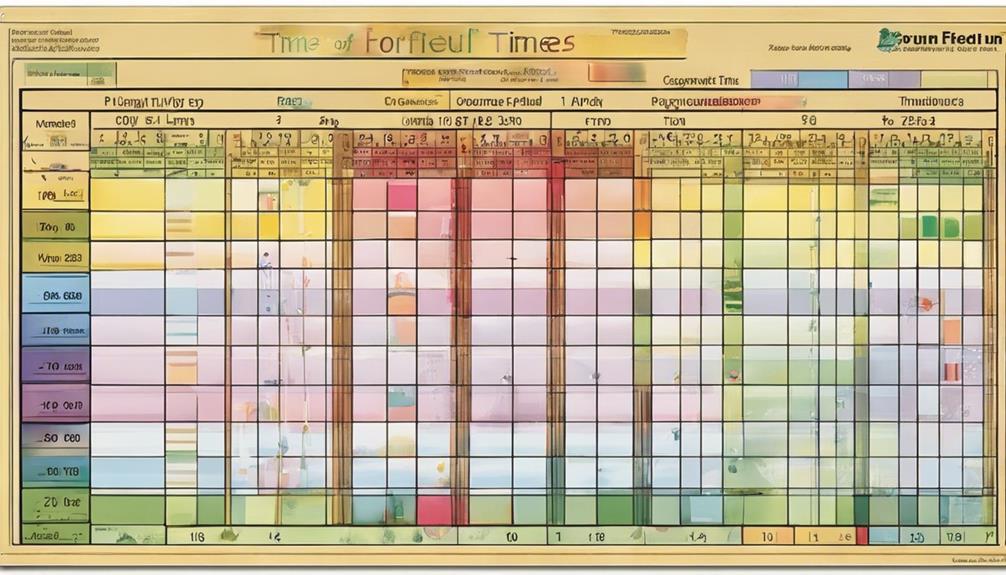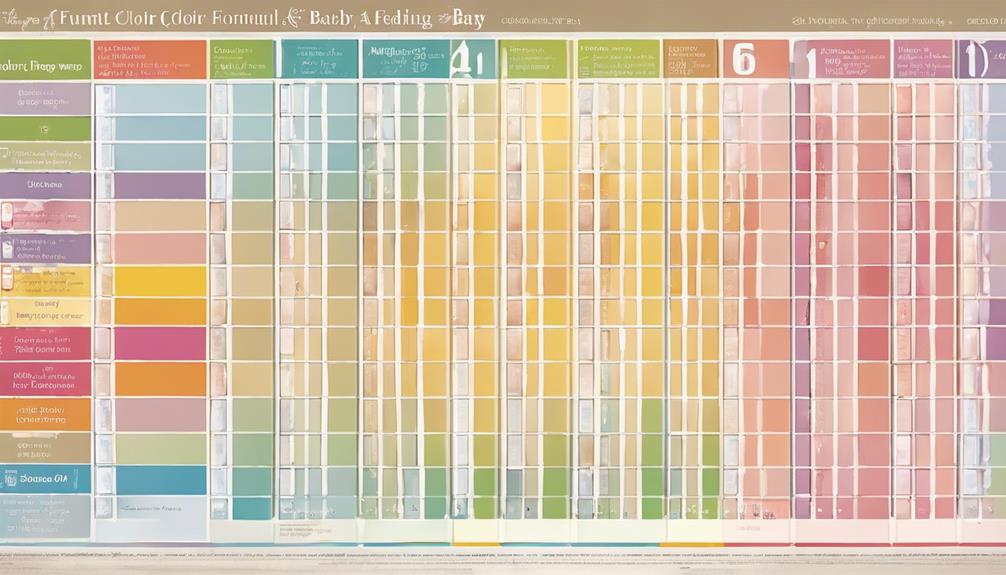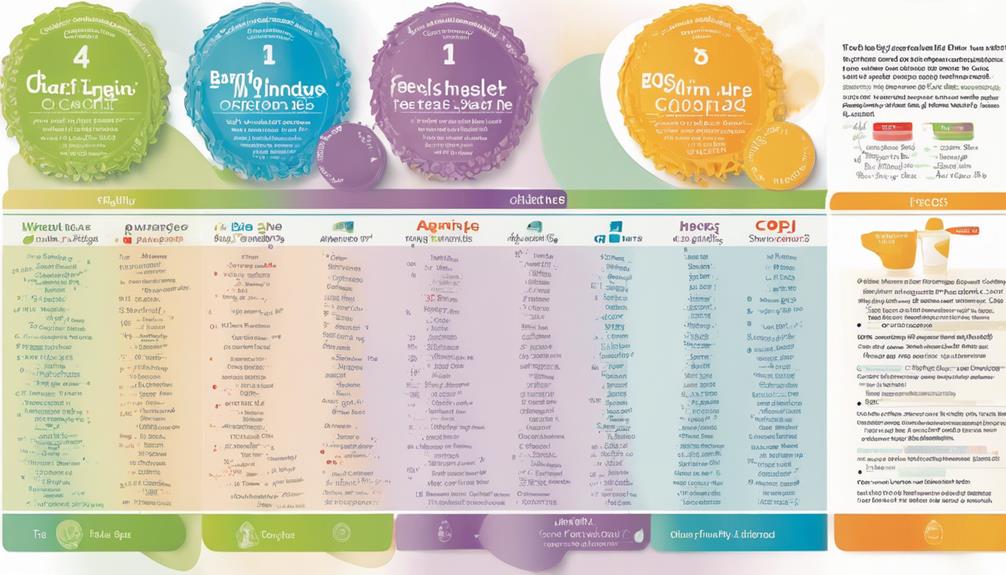Let’s talk about the top ten strategies for mastering the use of baby formula feeding charts.
Understanding the intricacies of feeding schedules and recognizing your baby's cues can make a world of difference in their well-being. From the importance of portion control to the gradual introduction of solid foods, these tips provide a solid foundation for nurturing healthy eating habits in your little one.
But what about those unexpected challenges that can arise along the way? Stay tuned to discover how to tackle those hurdles with confidence and ease.
Key Takeaways
- Monitor and adjust formula intake with a feeding chart for optimal nutrition.
- Recognize hunger cues to prevent under or overfeeding.
- Establish a consistent feeding routine to promote healthy habits.
- Use a formula feeding schedule to track intake and develop a predictable routine.
Importance of Baby Formula Feeding Chart
Understanding the significance of utilizing a baby formula feeding chart is important for caregivers to guarantee excellent nutrition and feeding practices for infants. The infant formula feeding chart plays a critical role in helping caregivers monitor the amount of formula consumed by the baby.
By following the guidelines on the chart, caregivers can make sure that the infant receives the appropriate amount of formula tailored to their developmental stage. This monitoring process is essential in preventing overfeeding, which can lead to various health issues.
Additionally, the feeding chart serves as a valuable tool in meeting the baby's nutritional needs accurately. As babies grow and their appetites change, the chart allows caregivers to adjust feeding amounts accordingly.
While personalized feeding guidelines from a pediatrician are recommended, the formula feeding chart acts as a reliable point of reference for caregivers to track and manage the baby's feeding routine effectively.
Understanding Baby's Feeding Patterns

As parents, we must be attentive to our baby's feeding frequency patterns, recognizing their hunger cues, and establishing a feeding routine that suits their needs.
Newborns often require frequent feedings during the day and night to support their rapid growth and development.
Feeding Frequency Patterns
When observing a baby's feeding patterns, it becomes evident that newborns typically feed every 2-3 hours, amounting to 8-12 feedings within a 24-hour timeframe.
Following the American Academy of Pediatrics feeding guide, parents may find it helpful to note the often to feed infant, considering hunger cues such as rooting, sucking motions, or hand-to-mouth gestures. Bottle feeding can help monitor the amount and schedule more easily.
As babies grow, feeding sessions may space out to every 3-4 hours, with some having longer or shorter feeding sessions. Initially, parents may need to wake newborns for feedings if they sleep too long.
Babies between 6-12 months usually require formula or solid foods 5-6 times a day as their intake changes.
Recognizing Hunger Cues
Noticing hunger cues in infants is essential for maintaining a healthy feeding routine and preventing over or underfeeding. Understanding your baby's hunger signals is important in establishing a successful feeding pattern. Babies communicate their hunger through various cues, such as sucking on fists or fingers, rooting, and increased alertness. Responding promptly to these cues can prevent the baby from getting overly hungry and reaching the crying stage. By recognizing and acting on these early signs of hunger, you can avoid overfeeding or underfeeding, ensuring that your baby receives the right amount of nourishment. Below is a table summarizing common hunger cues in infants:
| Hunger Cue | Description | Significance |
|---|---|---|
| Sucking on fists or fingers | Indicates readiness to feed | Early hunger cue |
| Rooting | Turning head towards a stimulus | Sign of hunger |
| Making sucking sounds | Mimicking the sucking motion | Baby is hungry |
Establishing Feeding Routine
To establish a consistent feeding routine aligned with your baby's natural patterns, tracking feeding times and amounts is essential. Understanding your baby's hunger cues, such as rooting, sucking, or fussiness, can guide you in knowing when it's time to feed.
Newborns typically feed every 2 to 3 hours, amounting to 8 to 12 feedings within 24 hours. As your baby grows, these feedings may space out to every 3 to 4 hours, depending on their individual needs.
Using a Formula Feeding Schedule

Establishing a formula feeding schedule can provide structure and consistency in a baby's feeding routine, aiding in tracking their formula intake for peak nutrition. When using a formula feeding schedule, consider the following tips:
- Consistency: Scheduled feedings can help babies develop a predictable routine, promoting healthy eating habits.
- Organization: Following a schedule can aid in tracking formula intake and ensuring your baby is receiving the necessary nutrients.
- Efficiency: Consistency in feeding times can assist in managing feedings alongside other daily tasks, making the process more efficient.
- Flexibility: Adjusting the schedule based on the baby's cues and needs is key to successful formula feeding, allowing for personalized care and meeting the baby's individual requirements.
Adjusting Formula Amounts as Needed

As caregivers, we must closely observe our baby's hunger cues and weight gain to adjust formula quantities effectively. Seeking guidance from a pediatrician can provide tailored advice on increasing or decreasing formula amounts based on your baby's unique needs.
Remember to remain adaptable, using a feeding chart as a general reference while prioritizing your baby's signals to confirm they receive the right amount of nutrition.
Monitor Baby's Appetite
When monitoring a baby's appetite for formula feeding, it's crucial to observe their hunger cues like sucking and rooting to determine the appropriate adjustment in formula amounts.
Here are some tips to help you adjust the formula amounts based on your infant's needs:
- Observe Hunger Signals: Watch for signs of hunger such as increased alertness or putting hands to mouth.
- Assess Feeding Frequency: Pay attention to how often your baby is feeding and the size of each feeding.
- Consider Weight and Age: Adjust formula amounts based on your baby's weight, age, and growth patterns.
- Consult Pediatrician: If unsure about adjusting formula amounts, seek guidance from a pediatrician to guarantee your baby's nutritional needs are met.
Consult Pediatrician for Guidance
Seeking guidance from a pediatrician is important in adjusting formula amounts to make sure your baby's nutritional needs are met effectively. Pediatricians offer personalized advice tailored to your baby's age, weight, and feeding patterns, ensuring ideal nutrition as their needs evolve.
Regular consultations with a pediatrician are essential to address any changes required due to growth spurts or shifts in appetite. Monitoring your baby's weight gain and overall development allows the pediatrician to recommend appropriate adjustments in formula quantities.
This personalized guidance helps maintain ideal nutrition and supports healthy feeding practices. By collaborating closely with a pediatrician, you can make sure that your baby receives the right amount of formula to support their growth and development effectively.
Monitoring Baby's Weight Gain
Monitoring your baby's weight gain is essential for guaranteeing they're growing healthily and getting the nutrition they need. Regularly tracking your infant's weight gain provides valuable insights into their development and overall well-being.
Here are some key tips for monitoring your baby's weight gain effectively:
- Regular Weigh-ins: Weigh your baby regularly to track their weight gain patterns over time.
- Comparison with Growth Chart: Compare your baby's weight to the standard growth chart to guarantee they're within the healthy range.
- Consultation with Pediatrician: If you notice any significant changes or concerns regarding your baby's weight gain, consult with your pediatrician for guidance and support.
- Adjusting Formula Feeding: Your baby's weight gain can indicate if adjustments are needed in their formula feeding routine to guarantee they're receiving adequate nutrition.
Consulting With a Pediatrician

Consulting with a pediatrician is important for obtaining personalized guidance on formula feeding tailored to your baby's unique needs. Every baby is different, and a pediatrician can provide valuable insights on the amount of formula to give, the type of formula that suits your baby best, and the feeding schedule that aligns with their nutritional requirements.
Pediatricians can address concerns regarding feeding your baby, such as how to adjust the amount of formula as your baby grows and guarantee they're receiving adequate nutrition for peak development. By consulting with a pediatrician, you can receive expert advice on any feeding-related issues and feel confident in your approach to formula feeding.
Additionally, pediatricians can offer recommendations on switching from formula to cow's milk when the time is right, supporting a smooth and healthy progression in your baby's diet. Partnering with a pediatrician guarantees that you're equipped with the knowledge and support needed to nourish your baby effectively.
Staying Consistent With Feedings

Moving from consulting with a pediatrician, it's important to emphasize the significance of staying consistent with feedings to establish a routine for your baby's feeding schedule and promote healthy growth and development. Consistency in feedings plays a critical role in ensuring your baby receives adequate nutrition and grows optimally. Here are some essential tips to help you stay on track with your baby's feedings:
- Follow a Feeding Chart: Utilize a feeding chart to track your baby's feeding times and amounts, helping you maintain a regular feeding schedule.
- Avoid Skipping Feedings: Make sure you don't skip or delay feedings as this can disrupt the routine and affect your baby's nutrition intake.
- Prevent Overfeeding: Consistent feedings can help prevent overfeeding issues, promoting healthy weight gain and digestion.
- Establish a Routine: By staying regular with feedings, you help your baby adapt to a predictable schedule, which is beneficial for their overall development and well-being.
Introducing Solid Foods Gradually

When it comes to introducing solid foods gradually, we aim to make a smooth shift process for babies.
By choosing age-appropriate food options, we can help infants adjust to new textures and flavors.
It's important to offer a variety of single-ingredient purees to gauge their preferences and monitor for any potential allergic reactions.
Smooth Transition Process
To facilitate a smooth shift process when introducing solid foods gradually to your baby, consider offering small amounts of easily digestible pureed fruits or vegetables initially. When introducing solid foods to your baby, keep in mind the following tips:
- Start Slow: Begin with small amounts of pureed fruits or vegetables to allow your baby to adjust gradually.
- Observe for Reactions: Watch for any signs of allergies or intolerances when introducing new foods.
- Gradually Increase Variety: Slowly introduce a variety of foods to expand your baby's palate and provide essential nutrients.
- Maintain Breastfeeding or Formula Feeding: Solid foods should complement, not replace, breast milk or formula to warrant your baby receives adequate nutrition.
For further guidance on introducing solid foods smoothly, consult with your pediatrician or healthcare provider.
Age-Appropriate Food Choices
As infants around 6 months of age begin their journey towards solid foods, it's crucial to introduce age-appropriate food choices gradually to support their growing nutritional needs. Start with small amounts of single-ingredient foods like pureed fruits or vegetables and gradually increase variety as your baby shows readiness.
Iron-rich foods such as fortified cereals, pureed meats, or legumes are vital. Avoid honey, cow's milk, nuts, seeds, and other choking hazards during the first year. It's vital to monitor your baby's weight and feeding habits to make sure they're getting adequate nutrition.
Typically, babies around 6 months old consume about 4-6 ounces of formula per feeding, about 4-5 times a day.
Keeping Track of Feeding Times
Tracking feeding times is essential for establishing a routine and ensuring consistent intervals between each feeding session. By recording the time of each feeding session, you can identify patterns in your baby's feeding schedule and detect any irregularities that may arise. To effectively keep track of feeding times, consider the following tips:
- Use a Feeding Log: Utilize a feeding log or app to document feeding times, amounts consumed, and any observations about your baby's behavior during and after feedings.
- Monitor Regularly: Regularly monitoring feeding times can help you stay attuned to your baby's needs and identify any changes in their feeding routine.
- Establish Consistency: Being consistent with feeding times can assist in setting up a feeding schedule that best suits your baby's requirements.
- Analyze and Adjust: Analyze the feeding data you've collected to make informed adjustments as needed and discuss any concerns with your pediatrician promptly.
Being Flexible With Feeding Routines

When adapting feeding routines for your baby, staying open to adjustments based on their hunger cues and growth spurts is key to ensuring top-notch nutrition and comfort. Babies go through growth spurts where their appetite may increase suddenly, requiring more frequent feedings. Being flexible with feeding schedules allows for responsive feeding, ensuring your baby receives the nutrition they need during these periods. It's important to understand that a balanced approach to feeding involves tuning in to your baby's cues and adapting accordingly. Developmental milestones can also impact feeding patterns, so being open to changes in routine is beneficial for both you and your little one.
| Baby's Hunger Cues | Growth Spurts | Feeding Schedules |
|---|---|---|
| Crying, sucking on fists | Rapid increase in appetite | Adjust based on baby's needs |
| Smacking lips, rooting | Temporary period of frequent feeding | Offer more feeds as required |
| Turning head towards bottle | Usually occurs around 2-3 weeks, 6 weeks, 3 months | Stay responsive to hunger signals |
Frequently Asked Questions
How Much Formula Should a Baby Drink Chart?
We base the baby's formula intake on their weight, typically aiming for 2 to 2½ ounces per pound. Daily amounts vary from 18 to 32 ounces. Watch for hunger cues like sucking or fussiness. Adjust feedings based on baby's cues for the best nourishment.
What Is the Rule of Thumb for Formula Feeding?
We typically follow the rule of 2 to 2½ ounces of formula per pound of body weight daily for infants under 6 months. Adjust based on hunger cues. A 10-pound baby may need about 25 ounces in 24 hours.
What 4 Tips Are Recommended for Bottle Fed Babies?
We watch for hunger cues like sucking and rooting in bottle-fed babies. Starting with small amounts, we gradually adjust feedings based on their signals. Never force a baby to eat more than they want. Trust their cues for successful feedings.
What Is the Feeding Pattern for a Formula-Fed Infant?
We typically feed formula-fed infants 2 to 2½ ounces per pound of body weight daily. Their feeding pattern may include 3 to 4 ounces every 4 hours, guided by hunger cues like sucking or rooting.
Conclusion
To sum up, following the 10 essential baby formula feeding chart tips can greatly benefit your baby's health and development.
Did you know that infants who are overfed are at a higher risk for obesity later in life?
By implementing these tips, you can guarantee your baby receives the right amount of nutrition while promoting healthy feeding habits for a lifetime.
Remember, your baby's well-being starts with proper feeding practices.










